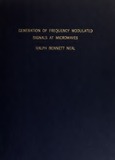Generation of frequency modulated signals at microwaves
| dc.contributor.advisor | Cooper, Gene | |
| dc.contributor.advisor | Menneken, Carl | |
| dc.contributor.author | Neal, Ralph Bennett | |
| dc.date | 1954 | |
| dc.date.accessioned | 2012-10-10T19:59:04Z | |
| dc.date.available | 2012-10-10T19:59:04Z | |
| dc.date.issued | 1954 | |
| dc.description.abstract | Present trends indicate that the microwave frequency range will be used extensively for communiaiton systems. Few such systems except those of the radio relay type are employed today, but as crowding continues in the UHF region, and the desire for greater security increases, it is believed that much of the traffic for nearby locations will be shifted to "point to point" systems in the microwave range. Further, it is believed that the frequency modulation technique allows utilization of most of the advantages found in this range withour introducing undue complexity to the system. The one operation for a communication system at microwave frequencies that is different from those encountered either in low frequency communications systems or in radar systems is the frequency modulated signal generation. Because of this difference, consideration of such signal generationi is of interest. Therefore, this paper presents descripitions and analyses of the more promising devices and methods for producing frequency modulated signals at microwave frequencies. By comparing the results shown herein, the device or method most suitable for a given system may be selected. Where applicable, specific information may be substituted into the equation given for freqency, modulation sensitivity, and distrotion to obtain an estimate of these factors for a partcular situation. One exception to the above statement must be made. The reactance tube method is not considered a practical or promising system at the present stage of development. Its inclusion is for comparison purposes with the other systems in order to form a bridge between the frequency modulation metrhods employed at low frequencies and those encountered at microwaves. For eaxmple, by such comparision, it may be seen that the microwave devices tend to introduce only a small percentage of the distortion that is inherent in the reactance tube modulator. | en_US |
| dc.description.uri | http://archive.org/details/generationoffreq1094514231 | |
| dc.language.iso | en_US | |
| dc.publisher | Monterey, California, Naval Postgraduate School | en_US |
| dc.rights | This publication is a work of the U.S. Government as defined in Title 17, United States Code, Section 101. Copyright protection is not available for this work in the United States. | en_US |
| dc.subject.lcsh | Electronics | en_US |
| dc.title | Generation of frequency modulated signals at microwaves | en_US |
| dc.type | Thesis | en_US |
| dc.contributor.department | Department of Electronics | |
| dc.description.service | Captain, United States Marine Corps | en_US |
| dc.identifier.oclc | ocn640262687 | |
| etd.thesisdegree.name | M.S. in Engineering Electronics | en_US |
| etd.thesisdegree.level | Masters | en_US |
| etd.thesisdegree.grantor | Naval Postgraduate School | en_US |
| dc.description.distributionstatement | Approved for public release; distribution is unlimited. |
Files in this item
This item appears in the following Collection(s)
-
1. Thesis and Dissertation Collection, all items
Publicly releasable NPS Theses, Dissertations, MBA Professional Reports, Joint Applied Projects, Systems Engineering Project Reports and other NPS degree-earning written works.





